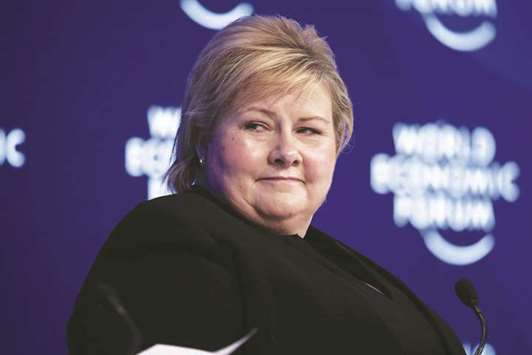As many investors question a global stock-market rally that’s now in its eighth year, the world’s biggest wealth fund is prepared to splurge.
Norway’s $970bn wealth fund has been ordered to raise its stock holdings to 70% from 60% in an effort to boost returns and safeguard the country’s oil riches for future generations. Any short-term view on growing risks will play little part, according to Trond Grande, the fund’s deputy chief executive.
“We don’t have any views on whether the market is priced high or low, whether bonds and stocks are expensive or cheap,” he said in an interview after presenting second-quarter returns in Oslo yesterday. The decision to add stocks “was made at a strategic level, on a long-term expected excess return that we’re willing to take risk to achieve. And parliament has said that they wish to spend some time to phase in that increase.”
The fund has doubled in value over the past five years and is continually adding risk to its portfolio. It returned 202bn ($26bn) kroner in the second quarter, and 499bn kroner in the first half, the best on record for the period.
Owning 1.3% of global stocks, the Norwegian fund largely follows indexes but is allowed some active management of its portfolio. It has been expanding more into emerging markets and recently got permission to raise its stock holdings after Norway last year started withdrawing cash from the fund for the first time.
While the investor can look beyond short-term, or even medium-term volatility, it does see potential risks. Chief executive officer Yngve Slyngstad in April said that the fund had turned a bit “cautious” on stocks. But in practical terms, that means very little. “It doesn’t lead to anything in concrete terms, other than the fact that we’re keeping a close eye on the indicators that could indicate whether there’s a risk there, and what they’re saying,” Grande said. “Some risk indicators have actually not shown underlying risk — take growth for example. So you should be a little cautious when the skies are all blue.” The fund held 65.1% in stocks in the quarter, 32.4% in bonds and 2.5% in properties. Its mandate is now to keep about 70% in stocks, 30% in bonds, with about 7% in real estate that’s now separate from the main portfolio.
The Finance Ministry is currently working on a plan on how to move the portfolio to 70% and the fund will stick to that, Grande said.
The fund also indicated it can withstand pressure on its balance sheet from government withdrawals. Norway started taking money out of the fund last year for the first time to cover budget shortfalls after oil revenue slumped. The government withdrew 16bn kroner in the second quarter, reaching about 36bn kroner so far. It has flagged it will take out just a little bit above 70bn kroner.
Norges Bank deputy governor Egil Matsen, who’s in charge of oversight of the fund, says it’s liquid and can finance new real estate purchases from a steady income stream.w
PM says time for govt spending to ‘take a step back’
Reuters/Oslo
Norway’s economic growth will exceed its historical average in 2018, and the government should “take a step back” on fiscal spending, Prime Minister Erna Solberg said yesterday.
The economy of western Europe’s top producer of oil and gas was hit by a sharp fall in the price of crude from 2014 to 2016, but growth has since picked up along with a partial recovery in oil prices.
“It was right to spend more money when that was needed, but now it’s time to take a step back,” Solberg told a news conference ahead of a two-day government budget conference.
“Next year we expect the mainland economy to grow more rapidly than its historical average,” she added.
The annual spending of cash from the country’s $975bn sovereign wealth fund, the world’s largest, should stay at 3% or below, Solberg said.
With less than three weeks to go before parliamentary elections, opinion polls show the minority right-wing government and its centrist backers are locked in a too-close-to-call race with the centre-left opposition.

u201cIt was right to spend more money when that was needed, but now it’s time to take a step back,u201d says Solberg.

